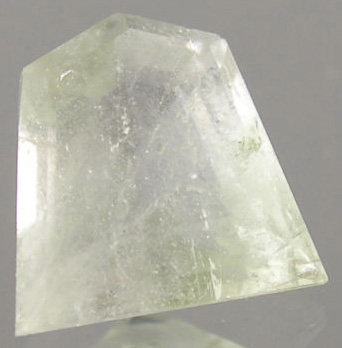Augelite
Augelite is a rare gemstone which was first noted in 1868 by Christian Wilhelm Blomstrand from a discovery in an iron mine at Scania in Sweden. Its first full description was from Spencer, in 1894. Augelite is usually a colorless or pale green to apple green gemstone but is also found extremely rarely in the colors of yellow, pale blue or rose pink.

Augelite
(faceted, from Peru. Weight: 0.45 carats)
Image © supplied by Woodmansee* Gems
Almost 80 percent of all Augelite crystals found are either greenish, white or colorless. Augelite derives its name from auge, a Greek word which literally translates into luster or shine and is named due to the shiny or pearly luster of the cleavage surfaces of this rare gemstone. [1]
Augelite Properties
Augelite is an aluminum phosphate mineral with the chemical formula Al(PO4)(OH)3 and a molecular weight of 199.96 gm. The gemstone contains 27 percent aluminum, 15.5 percent phosphorus and 56 percent oxygen. The crystals of Augelite have a monoclinic prismatic composition which also gives the pearly sheen seen on the cleavages of the crystals.
Augelite crystals are extremely brittle and can be broken with bare hands due to the irregular and uneven fracturing. For this reason, Augelite is not often cut, typically being considered to be a collector’s mineral and not known very well in the gemstone market. However it has on occasion been faceted - such as the example shown in the image. Examples of cut augelite generally range in color from colorless through to a pleasing apple-green and translucent to transparent gem.
The hardness of Augelite has been put at 4.5 to 5 of Moh’s hardness. The irregular and brittle nature of Augelite causes it to be not very dense at just 2.5 g/cm3. Augelite has a specific gravity of 2.696 (compare with diamond at 3.52). Augelite also does not have any luminescence properties and is neither radioactive. Like many gemstones the crystals of Augelite are soluble in hot and concentrated hydrochloric acid. Augelite however dissolves extremely slowly often requiring a few hours to completely dissolve in hot and concentrated hydrochloric acid.
Augelite in its natural form occurs as thick and tabular crystals up to 13 cm - however examples of crystals are generally seen up to 2 or 3 cm across. The crystals are often prismatic and sometimes even acicular (needle-like). Augelite varies from being completely transparent to being translucent with a vitreous luster that turns to a pearly sheen on the fractures of the crystals.
Augelite - Occurrence
Augelite naturally occurs in significant amounts in Austria, Bolivia and Peru. Traces of Augelite have also been found in Sweden since its first discovery in 1868. Other localities listed [1] include Eastern Siberia, Czech Republic, China, Canada and several locations in the USA, however most of the augelite found is in the form of massive or tiny crystals. The best quality crystals of augelite are reported [2] to be those from White Mountain, Mono County, California. Augelite is formed by the hydrogen induced metamorphism of rocks bearing phosphate in peraluminous sediments. [3]
Augelite has been found in association with the minerals attakolite, svanbergite, lazulite, Hematite, trolleite, berlinite, rutile, pyrophyllite, baryte, arsenopyrite, stannite, Pyrite, andorite, Cassiterite and zinkenite. [4]
Back to the Gemstones List home page - over 160 gemstones explored!
Sources Referenced:
[1] http://www.mindat.org/min-451.html
[2] http://www.galleries.com/Augelite
[3] http://www.handbookofmineralogy.org/pdfs/augelite.pdf
[4] http://en.wikipedia.org/wiki/Augelite
Please feel free to link to this page - copy / paste the text below: (click to select)
Privacy Policy | Cookie Policy | GDPR | About This Site / Terms

© gemstoneslist.com


